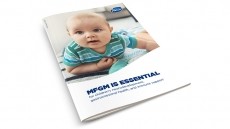Probiotic supplementation may alter structure of HMOs in breastmilk: Study

Finnish and US researchers collaborating on the study found maternal probiotic supplementation during late stages of pregnancy could change the human milk oligosaccharide (HMO) core structures.
“Here, we have the first example suggesting that maternal dietary microbes, in the form of probiotics, shape HMO compositions,” said Dr Lars Bode, associate professor of paediatrics at the University of California San Diego, who co-authored the letter.
“We thought the interaction between HMOs and the microbiome was a one-way street, with HMOs shaping microbial communities by acting as prebiotics.”
Revise HMO thinking
The finding, published in a research letter in the journal, revises current thinking among the scientific community about HMOs.
Human milk oligosaccharides (HMOs) are complex glycans and the third-largest solid component in human milk.
They are typically nondigestible by humans but are a major substrate for infants’ gut microbiota and affect the maturation of the intestinal mucosal immune system.
All HMOs are extensions of lactose generated by the action of a series of glycosyltransferases.
Depending on genetic makeup of the mother’s blood, certain HMOs are produced. Thus, some breastfed infants are not exposed to certain structures, which may affect their microbiome composition and risk for illnesses in which gut microbiome plays a role.
Infants fed by mothers who lack the Secretor gene and therefore lack a functional enzyme and all α-1-2-fucosylated oligosaccharides have delayed development of bifidobacteria-laden microbiota.
The same team recently showed that certain HMOs are associated with protection against cow-milk allergy in infants.
Additional research has also shown that besides genetic differences that are responsible for differences in HMO profiles, HMO abundance changes throughout lactation.
Study details
The study analysed data from 81 pregnant women who were enrolled in a probiotic supplementation study in Finland. The team then randomly selected 30 colostrum samples from the placebo group and 51 from the probiotic group.
The children born to these mothers were followed up for 10 years for the development of allergic disease.
In the probiotic group, mothers took twice-daily doses of Lactobacillus rhamnosus GG, Lactobacillus rhamnosus LC705, Bifidobacterium breve Bb99, and Propionibacterium freudenreichii subspecies shermanii JS in capsules from 36 weeks’ gestation until the birth of the infant.
The researchers then compared 20 different HMOs in the two groups of women and found concentrations of the HMO 3-fucosyllactose were significantly higher in colostrum from the mothers in the probiotic supplementation group compared with those in the non-supplemented group.
Likewise, 3′-sialyllactose was higher in colostrum from the probiotic supplementation group than in control participants.
“HMOs were thought to be genetically determined, almost like your blood type,” said Dr Antti Seppo, research associate professor of paediatric allergy/immunology at University of Rochester Medical Center (URMC) and the letter’s lead author.
“But this data shows you can manipulate the HMOs by external factors.”
Hope for food allergies?
Dr Kirsi Jarvinen-Seppo chief of the division of paediatric allergy/immunology at URMC and senior co-author on the paper added that because HMOs may be linked to development of food allergies in an infant, manipulating HMO composition favourably could open up a new avenue for prevention of food allergies.
“Maternal diet, medications, and microbiome may be important factors modulating a mother’s colostrum HMO levels that should be considered when assessing biological effects suspected to be mediated by HMO levels,” the study concluded.
“Ultimately, modifying mothers’ milk HMO composition may open new avenues for disease modification in infants who are breastfed.”
Source: JAMA Pediatrics
Published online: doi:10.1001/jamapediatrics.2018.4835
“Association of Maternal Probiotic Supplementation With Human Milk Oligosaccharide Composition.”
Authors: Antti Seppo, Anna Kukkonen, Mikael Kuitunen, Erkki Savilahti, Chloe Yonemitsu, Lars Bode, Kirsi Järvinen.

















